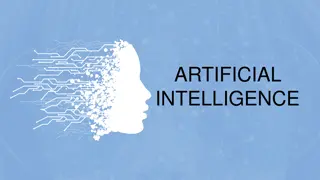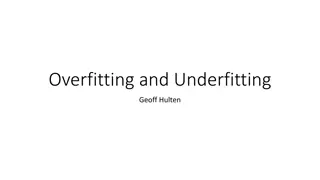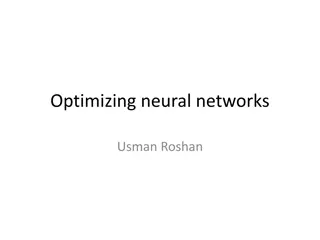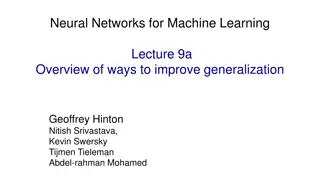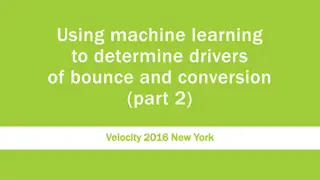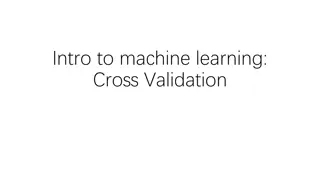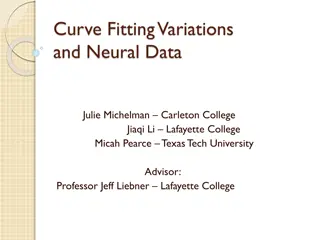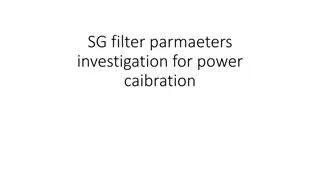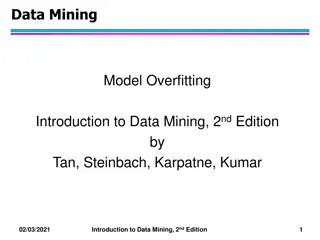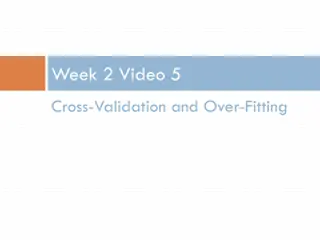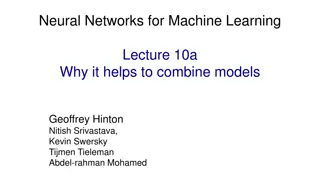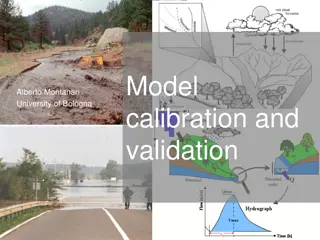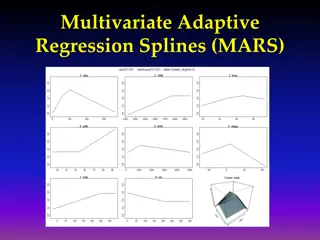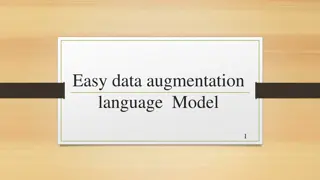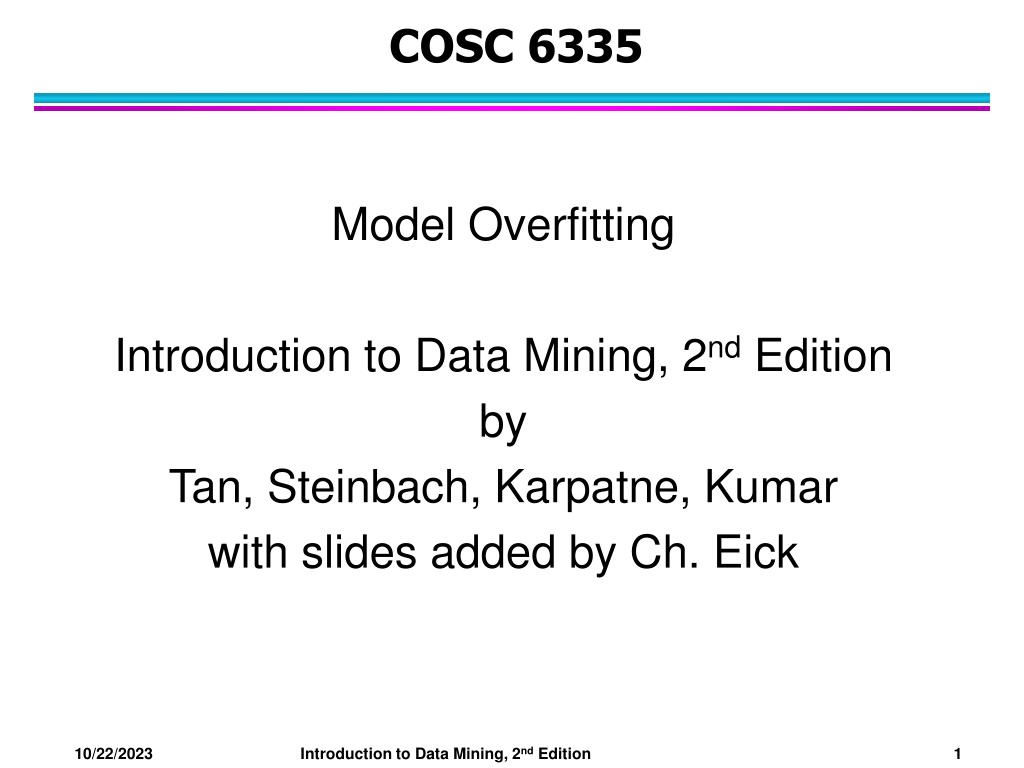
Understanding Model Overfitting in Data Mining
Explore the concept of model overfitting in data mining, including classification errors, generalization errors, decision trees, and the impact of model complexity on training and test errors. Learn how to identify and address overfitting and underfitting issues for better model performance.
Download Presentation

Please find below an Image/Link to download the presentation.
The content on the website is provided AS IS for your information and personal use only. It may not be sold, licensed, or shared on other websites without obtaining consent from the author. If you encounter any issues during the download, it is possible that the publisher has removed the file from their server.
You are allowed to download the files provided on this website for personal or commercial use, subject to the condition that they are used lawfully. All files are the property of their respective owners.
The content on the website is provided AS IS for your information and personal use only. It may not be sold, licensed, or shared on other websites without obtaining consent from the author.
E N D
Presentation Transcript
COSC 6335 Model Overfitting Introduction to Data Mining, 2nd Edition by Tan, Steinbach, Karpatne, Kumar with slides added by Ch. Eick 10/22/2023 Introduction to Data Mining, 2ndEdition 1
Classification Errors Training errors (apparent errors) Errors committed on the training set Validation Set errors Errors committed on validation set for hyper parameter selection Test errors Errors committed on the test set Generalization errors Expected error of a model over random selection of records from same distribution 10/22/2023 Introduction to Data Mining, 2nd Edition 2
Example Data Set Two class problem: + : 5200 instances 5000 instances generated from a Gaussian centered at (10,10) 200 noisy instances added o : 5200 instances Generated from a uniform distribution 10 % of the data used for training and 90% of the data used for testing 10/22/2023 Introduction to Data Mining, 2nd Edition 3
Increasing number of nodes in Decision Trees 10/22/2023 Introduction to Data Mining, 2nd Edition 4
Decision Tree with 4 nodes Decision Tree Decision boundaries on Training data 10/22/2023 Introduction to Data Mining, 2nd Edition 5
Decision Tree with 50 nodes Decision Tree Decision Tree Decision boundaries on Training data 10/22/2023 Introduction to Data Mining, 2nd Edition 6
Which tree is better? Decision Tree with 4 nodes Which tree is better ? Decision Tree with 50 nodes 10/22/2023 Introduction to Data Mining, 2nd Edition 7
Model Overfitting Underfitting: when model is too simple, both training and test errors are large Overfitting: when model is too complex, training error is small but test error is large 10/22/2023 Introduction to Data Mining, 2nd Edition 8
Model Overfitting Using twice the number of data instances If training data is under-representative, testing errors increase and training errors decrease on increasing number of nodes Increasing the size of training data reduces the difference between training and testing errors at a given number of nodes 10/22/2023 Introduction to Data Mining, 2nd Edition 9
Reasons for Model Overfitting Limited Training Set Size Non-Representative Training Examles High Model Complexity Multiple Comparison Procedure 10/22/2023 Introduction to Data Mining, 2nd Edition 10
Overfitting due to Noise Decision boundary is distorted by noise point 10/22/2023 Introduction to Data Mining, 2nd Edition 11
Overfitting due to Insufficient Examples Lack of data points in the lower half of the diagram makes it difficult to predict correctly the class labels of that region - Insufficient number of training records in the region causes the decision tree to predict the test examples using other training records that are irrelevant to the classification task 10/22/2023 Introduction to Data Mining, 2nd Edition 12
Occams Razor Given two models of similar generalization errors, one should prefer the simpler model over the more complex model For complex models, there is a greater chance that it was fitted accidentally by errors in data Usually, simple models are more robust with respect to noise 10/22/2023 Introduction to Data Mining, 2nd Edition 13
How to Address Overfitting Pre-Pruning (Early Stopping Rule) Stop the algorithm before it becomes a fully-grown tree Typical stopping conditions for a node: Stop if all instances belong to the same class Stop if all the attribute values are the same More restrictive conditions: Stop if number of instances is less than some user-specified threshold Stop if class distribution of instances are independent of the available features (e.g., using 2 test) Stop if expanding the current node does not improve impurity measures (e.g., Gini or information gain). 10/22/2023 Introduction to Data Mining, 2nd Edition 14
How to Address Overfitting Post-pruning Grow decision tree to its entirety Trim the nodes of the decision tree in a bottom-up fashion If generalization error improves after trimming, replace sub-tree by a leaf node. Class label of leaf node is determined from majority class of instances in the sub-tree 10/22/2023 Introduction to Data Mining, 2nd Edition 15
Example of Post-Pruning One approach is to use a separate validation set---which is like a test set that is used during training, and assess validation set accuracy for different tree sizes, and pick the tree with the highest validation set accuracy, breaking ties in favor smaller trees. Class = Yes 20 Class = No Error = 10/30 10 A? A1 A4 A3 A2 Class = Yes Class = No 8 4 Class = Yes Class = No 3 4 Class = Yes Class = No 4 1 Class = Yes Class = No 5 1 10/22/2023 Introduction to Data Mining, 2nd Edition 16
Final Notes on Overfitting Overfitting results in decision trees that are more complex than necessary: after learning knowledge they tend to learn noise More complex models tend to have more complicated decision boundaries and tend to be more sensitive to noise, missing examples, Training error no longer provides a good estimate of how well the tree will perform on previously unseen records: Need new ways for estimating errors; e.g. that use a validation set. When learning complex models, large representative training sets are needed. 10/22/2023 Introduction to Data Mining, 2nd Edition 17


